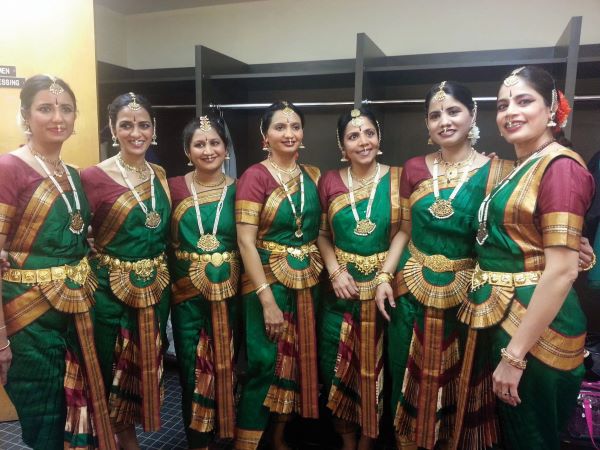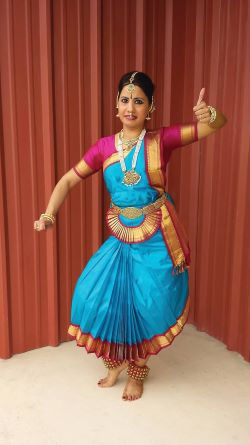
As Arathi Shah, MD, was finishing medical school in western India, a second crucible in the guise of a graduation ceremony awaited her. It also entailed yearslong preparation, rigorous training, and time with friends cut short.
Upon completion of a 10-year course in an Indian classical dance form called bharatanatyam, the now-Austin pediatrician prepared a multihour dance program to perform at this graduation ceremony after spending several weeks rehearsing the routine alongside an entourage of musicians.
“You prepare little pieces of 10 to 12 minutes along with your ensemble,” she said. The orchestral ensemble that accompanied her at the ceremony played Carnatic music, a classical genre that originated in southern India and comprises percussion, wind, and string musicians. She danced before an audience continuously for about three hours, with perhaps one 15-minute break.
“You prepare your mind and body for that,” Dr. Shah said, contrasting it to dancing in the Bollywood style, which she began to explore years later. “It’s a combination of many styles – honestly, there is no one style of Bollywood – but it’s more like a blend of a few styles and flowy, and this [Indian classical dance] is like you’re meditating while you’re in a disciplined form of dance.”
That meditation reinforces why dance is so important to her, she says.
“That [dance] is something I can say, outside of giving, whether it’s giving to others in my professional life and my family life, that is something that I do for myself,” Dr. Shah said. Whatever it takes up from her in time, it pays back tenfold. “I do this for myself, so I can be 100% for my family and for my patients and for my professional life. Dance has always given me that.”
Returning from hiatus
Dr. Shah displayed the discipline of bharatanatyam even at age 5, when she began her dance training. As her parents took turns shuttling her to classes three times a week, she built a base of knowledge and strength.
“The first couple of years, I remember just having to maintain some rigid postures called adavus and aramandi positions,” she said. “It’s almost like doing athletics and yoga, but in a form that’s balancing rigidity with flexibility: rigidity of the spine and posture with flexibility of the muscles. You’re building that up.”
After a near decade-long hiatus “because life happened,” the physiologic balancing act she’d achieved in her dance practice provided a handy mental blueprint. By 2011 and after a move to San Antonio, Dr. Shah was at her second attending job, and she had a family; life was full and busy.
“Dance was not a consistent routine or ritual for me at all after graduation from medical school in 2002,” she said. “Then I found my group in San Antonio. When we moved to a new city, we were looking out for our cultural traditions, as well as temples.” That search led her to a dance school that specialized in bharatanatyam, and to new friends.
After performing and coordinating stage productions – handling song selection, costume decisions, and reconciling conflicting schedules – with a couple of groups for several years, Dr. Shah and her family moved again, this time to Dallas, where the Dallas County Medical Society sponsored her attendance at the TMA Leadership College. During her time in the Metroplex, Dr. Shah would drive to San Antonio on weekends to rehearse with the group, returning to Dallas at midnight after an epic day trip.
“I used to drive down for five hours just to rehearse for two to three hours, spend a couple of extra hours socializing and then drive back to Dallas, all this just for the sake of dance,” she said.
The marathon day and commute might have felt grueling to some, but Dr. Shah credits her mental resilience to dance.
“It didn’t seem that way to me. It was so invigorating after doing that,” Dr. Shah said. “I don’t think I feel pain while I’m dancing [whether it’s] as little as hey, my heart is breaking because I think this didn’t go well with the family I saw earlier today, to a bigger pain.”

‘Part of my soul’
Dr. Shah counts creative expression among the benefits dance confers.
Over the years, she says dance has helped her liberate and express herself, but it also presents an opportunity to try to channel the intentions of a poet, lyricist, or choreographer.
“What has been penned into these lines [that] we are putting on? [I’m] not just bringing myself to it but taking something from that and presenting it to the audience,” she said.
Dr. Shah, who has been active in TMA outreach programs, has performed in Diwali celebrations in San Antonio and Round Rock as well as at the Festival of India, organized by the India Association of San Antonio.
“[Dance] has been a way to share, obviously, the culture and traditions of India,” she said. But it’s also formed the core of who she is, amid the demands of a full life as a physician and parent of a teenager.
It’s also instilled in her self-compassion, not to mention joy. To cure bouts of stage fright, Dr. Shah talks to herself kindly.
“I’ve learned to forgive myself onstage and improvise,” she said. Perfection isn’t the point, anyway. “It’s about jelling with the others in the group, so each one does their part and connects with the audience as a whole.”
It’s been an evolution.
“I used to be such a rigid student that I’d be so focused on the steps coming out right that I had not even been smiling on stage the first decade of my learning,” she said.
Though that has changed, dance’s centrality to her identity has not.
“I can’t imagine my life without dance,” Dr. Shah said. “It is a part of my soul.”
